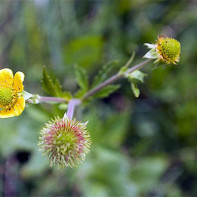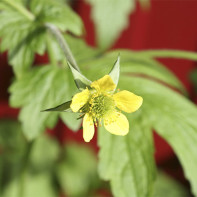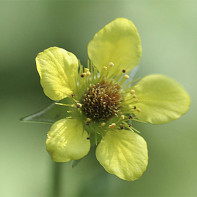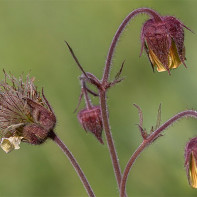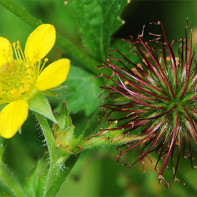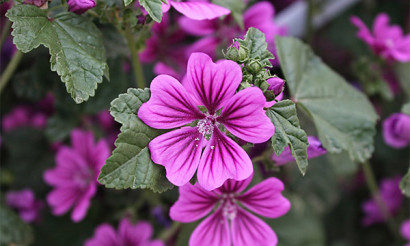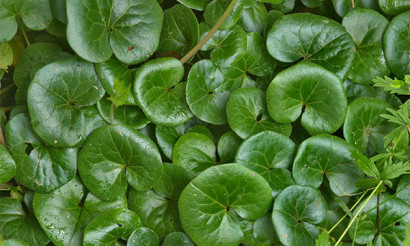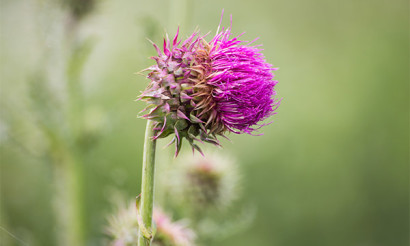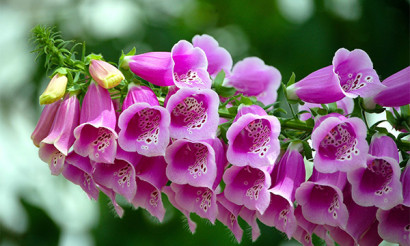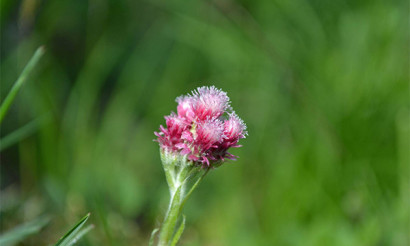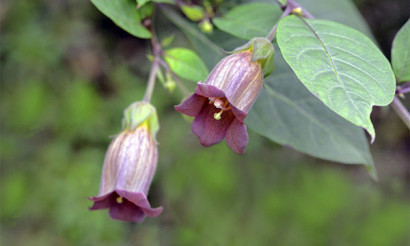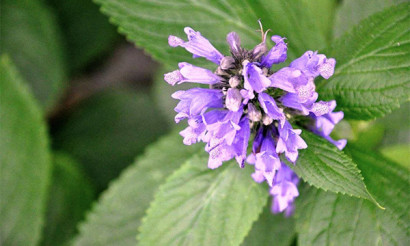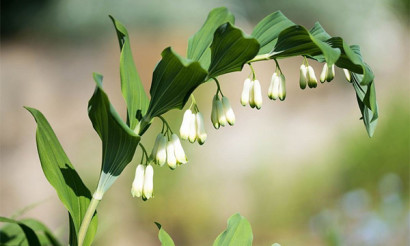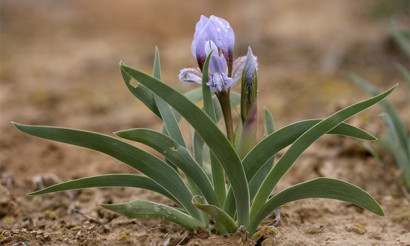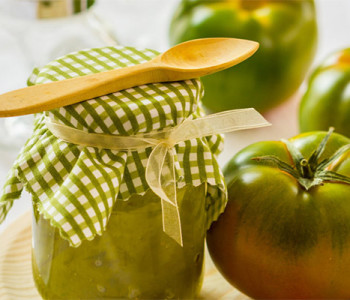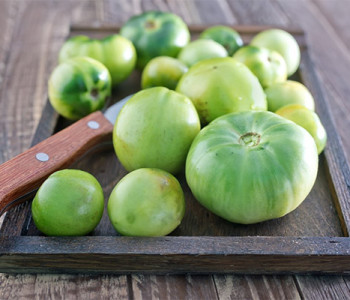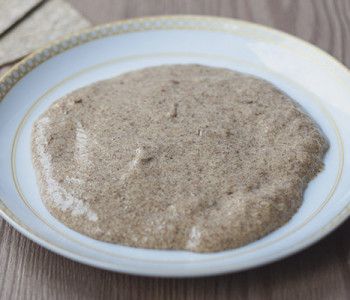Gravilat: medicinal properties and contraindications
Gravilat is found everywhere on the planet - perhaps except in Antarctica. This plant from the pink family is loved by landscapers and gardeners. It treats many diseases of various kinds. Women use it to make them beautiful and to put on the table culinary creations cooked with the addition of this pleasant, clove-scented plant. In addition, the rhizome is sometimes used as a tanning agent for leather and as a dye for fabrics, giving them golden and brown tones. People have invented many names for it. Perhaps the most memorable of them are clove potion, clove spirit and clove root, living grass, celandine grass, lovage, lovage grass, dogweed.
- Chemical composition
- How it looks and where it grows
- Types
- Gathering and storage
- Therapeutic properties of gravilat
- Gravilat in traditional medicine
- For Calluses
- For colds
- Cleanser
- Kids for rickets
- Digestive diseases
- Kidney diseases
- At bronchitis
- A styptic
- For gastritis
- Kinds of medicinal compositions
- Infusion
- Infusion
- Decoction
- Cosmetic applications
- Oily skin mask
- Body Bath
- For skin rashes
- From eczema and skin irritations
- Swelling of the face and spider veins
- Contraindications for use
Chemical Composition
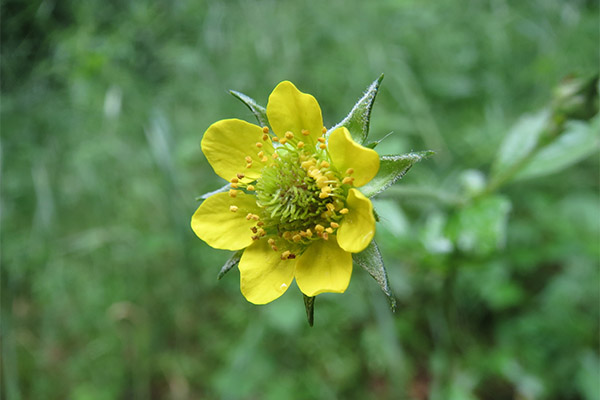
- The yellow coloring pigment and tannins are contained in the rhizomes of the plant, and there are many tannin ingredients - about 40% of the chemical composition.
- In addition to these components, the plant contains flavonoids, known for their strengthening effect on the walls of blood vessels. They provide their elasticity and reduce the permeability.
- The plant also contains a large set of carbohydrates. In combination with other useful substances - minerals, vitamins, flavonoids and flavones - they can suppress the action of free radicals, inhibit the process of oxidation of tissues and, consequently, delay both the external and internal aging of the body. In fact, these substances are true natural antioxidants. Of vitamins we should note the high content of carotene and ascorbic acid in the leaves, which determines the immune-stimulating effect of the plant.
- In friendly tandem with antioxidants also work bitter substances, as well as constituents of essential oil - they stimulate and control the metabolism in the body. By the way, the essential oil is contained in the rhizome in an amount of 0.4%. It seems to be a little, but it gives the plant a fairly consistent pleasant clove smell. The essential oil of gravilita is specially extracted by steam distillation, it is reddish in color. It is even used in the pharmaceutical industry to flavor medicines.
- Organic acids of gravilata play an important role in maintaining acid-base balance of the body, helps to improve all digestive system functions, eliminate toxins and maintain human performance in general.
- Quite a lot of plant tannins, in different parts of gravilat its content varies. But in general, it reaches 30%. These substances are known and widely used in medicine and pharmacy because they have a number of beneficial effects, such as hemostatic, anti-inflammatory, antimicrobial, antiseptic and antimalarial.
- Starch and polysaccharides, also found in this plant, provide energy for the body.
- It contains the glycoside heine. Like all substances of the glycoside group, it can be viewed both negatively and positively. It is poisonous in overdose, but when used intelligently, it will stimulate the appetite, has a local irritant effect, regulates the heart muscle and normalizes the vascular system, and actively combats pathogens.
What does it look like and where does it grow?
This perennial herbaceous plant reaches a height of 30 to 60 cm. It has a fairly thick rhizome, from which the root leaf rosette emerges. It consists of strongly toothed leaves attached to long petioles. The stem is straight, faceted, branching. It has few leaves, divided into three pointed sectors with denticles along the edge. They are attached to the stem by such short petioles that they appear to be sessile. The leaves vary in size - the root leaves are larger than the stem leaves. The entire green part of the plant is lightly covered with soft pubescence - small hairs.
Flowers are located at the tips of each stem branch; their pedicels are short and also covered with soft white hairs. Each flower is five-petaled, they are wide open and have a small notch along the edge, similar to a softly carved heart. The most common natural color of gravilitae flowers is yellow, less common can also be white or pink. They are gathered in inflorescences of 3 to 10 pieces each. Inflorescences come in a variety of forms, both umbrella-shaped and panicle-like.
The gravil blooms in late spring and early summer. After flowering, the fruits, called spores, appear, each of them full of seeds with a hooked tail at the end. They ripen in early September.
The plant does not need much soil, just poor and acidic soils. Mostly found on forest edges, it is ubiquitous in Europe, Asia, Africa, Australia and both the Americas. It neither resists the heat of the tropics or semi-deserts, nor the frosty Russian winters. The only continent without gravilita is Antarctica.
Species
In nature, there are about fifty varieties of gravilata, 20 of them are cultivated. In Russia, you can find 11 species - both in the natural environment and cultivated.
- Mountain gravilat. Its habitual habitat is the mountainous regions of Europe. This species is bushy but not tall - no more than 30 cm, its leaves are rough to the touch. The flower does not open fully and is therefore cup-shaped. It begins to bloom in June. Flowers have a bright yellow color, rather large - up to 4 cm across. Loves the sun, shade is not tolerated, the cold weather endures quite steadfastly.
- Gravilat creeping. Creeping gravilat in many ways similar to its mountain relative and grows in the neighborhood - in the Alps, the Balkans, the Carpathians. The plant is not tall, only 15 cm. Single golden-colored flowers begin to delight from the beginning of summer. It is often used to decorate flowerbeds.
- Urban Gravelat. Characterized by a very thick rhizome, for which it is valued by folk healers. Grows in all countries, in Russia it is most common in the Urals region. One of the tallest species - up to 70 cm. The flowers are small - about 1.5 cm, have a yellow, but rather light color, if not faded. It blooms in May and then forms many seeds that germinate quite easily, as a result, gravilat spreads quickly, crowding out all other grasses.
- Gravilatum tame. Typical resident of the American continent, but found in Eurasia as well. It is one of the few species of shingles able to live in abundantly moistened soil, including on the banks of rivers and lakes. Its rhizome is powerful and its height corresponds to its power, up to 70 cm. It is distinguished by the brown color of the stem. Flowers have an interesting coloring - yellow with red or red-brown stripes, have a bowl shape.
- Gravilat aleppe. Despite the high growth - 70 cm, has a short rhizome. It has an outward resemblance to the urban gravilat, but the Aleppo is more pubescent, one might even say furry. Its habitat is birch forests and their edges, as well as steppe meadows. Widespread throughout Russia, from its European part to the Far East, Central Asia and the North American continent. Self-sowing with the help of the wind spreads easily over decent distances and large areas. To limit its spreading, timely mowing is required - before the seeds begin to mature.
- Chilean Gravilat. It is native to Chile, hence the name. It is a tall and bushy plant covered with dense fuzz. It is characterized by large - about 4 cm - purple flowers, blooms quite long - from the end of May until the end of summer.
- Gravilat bright red. This species of gravilat is native to the Caucasus and the territory of the Balkan Peninsula. Based on the plant that came from these areas, breeders have bred a very beautiful flower, which is valued by landscape designers and gardeners. A tall bushy plant with large bright red flowers, gathered in a cap of 2-4 pieces. Blossoms from May to late summer.
- Gravilat is a large-leafed plant. From the name, we can see that the characteristic feature of this species is the larger foliage compared to other species. Each leaf is wide, egg-shaped. But the flowers are smaller, paler and more unsightly than those of related plants - only 1 cm in diameter. Flowering begins in May and ends in mid-summer. The homeland of this variety is North America.
- Gravilat rossa. This variety is remarkable because it is mainly distributed in cold climates - in the Arctic regions of the North American continent. Perfectly preserves and overwinters in such harsh conditions.
- Gravilat triflorum. This small perennial does not grow taller than 30 cm. Successfully used for design of flowerbeds and raceways, widely used not only in private but also in urban landscape design. Bright yellow flowers deliver aesthetic pleasure with their cheerfulness. Orange flowers may also appear among the bright yellow flowers.
- Gravilat hybrid. Breeders have developed many varieties of this species of gravilitae. They are mostly characterized by large inflorescences of orange and red hues. Some of the most popular varieties include the delicate orange Gladys Perry and Princess Juliana and the orange-red Fire Opal.
Gathering and storage
Since there is virtually no non-growing land for gravilita, it can be found in urban natural lawns and along roadsides. This plant should not be herbally harvested for medicinal purposes because it soaks up all the harmful substances from industrial emissions and car exhausts. It is better to go to the countryside, to the woods and meadows for picking.
The green part of the plant as well as its flowers should be harvested when it begins to bloom, by snipping off gravilata at the very base of the stem with a sickle. Harvesting is best done in the morning, but not too early, as you need enough time for the dew to dry.
You can dry the herbs as a whole or separate the flowers and make a separate billet. The drying conditions are the same. First, the medicinal raw material should be dried in the shade, in the fresh air, and the dried plant to bring to readiness in an electric dryer, setting the temperature at 45-50 degrees. To be more convenient to put the plant in the dryer, it is better to cut it into pieces beforehand.
Ready drugs is better to put in paper bags, cardboard boxes or cotton bags, in which they are stored in a dry room for no more than a year.
Rhizomes should be harvested in the fall, by this time they have time to accumulate the greatest number of medicinal substances. Mature plants are most suitable for medicinal purposes. Dug roots should be shaken off the soil, rinsed thoroughly with a brush and just like the green part, first air-dry and only then send in an electric dryer or drying cabinet, where the temperature is set to 45 degrees. Under such conditions, the remedy perfectly preserves both the useful substances and the characteristic distinctive smell of gravilata - the smell of cloves.
Store curative rhizomes in cotton bags in a dry room, under these conditions, they are suitable for use for three years.
Therapeutic properties of gravilat
Gravilat is a plant known as a medicinal as far back as Ancient Greece. It was the Greeks who described it in medical treatises. And the official medicine of our country, it is recognized in 1818 and included in the Russian pharmacopoeia.
Thanks to the substances in the composition of the medicinal plant, its preparations have anti-inflammatory, wound-healing, antiseptic, astringent, antimalarial, diaphoretic and restorative effects. Its compositions can relieve abdominal pain caused by spasms, eliminate bile stagnation, reduce fatigue and add vitality, reduce sweating.
From the medicinal plant is prepared water compositions - infusions and decoctions - and alcoholic tinctures, use gravilat directly - just crushing it to powder. In the list of diseases with which it copes - colitis of various origins, stomach catarrh, intestinal colic and increased gas, vomiting and dysentery. Gravilat also treats the respiratory organs - from simple cough to whooping cough, pneumonia, bronchial asthma and even tuberculosis. Nephritis and cystitis, cholecystitis and liver problems, neuroses and C-avitaminosis - for the treatment of all these diseases there is a recipe based on the healing plant.
Gravilat is also used to solve men's and women's delicate problems: get rid of impotence, take as a remedy to stimulate uterine contractions and stop bleeding - and not only uterine, but also hemorrhoidal.
The antiseptic and anti-inflammatory abilities of the herb are in demand for external use in the treatment of angina, periodontal disease, gingivitis and stomatitis - and, for very complicated and advanced cases, when even already observed necrotic tissue changes, to accelerate wound healing. Gravilat expels worms and fights rickets, is effective as an antiviral, diaphoretic, antimalarial and tonic.
Gravilat in folk medicine
According to centuries of tradition, folk medicine uses the medicinal plant to get rid of a wide range of problems - from ordinary sweating to serious - for example, such as tumors.
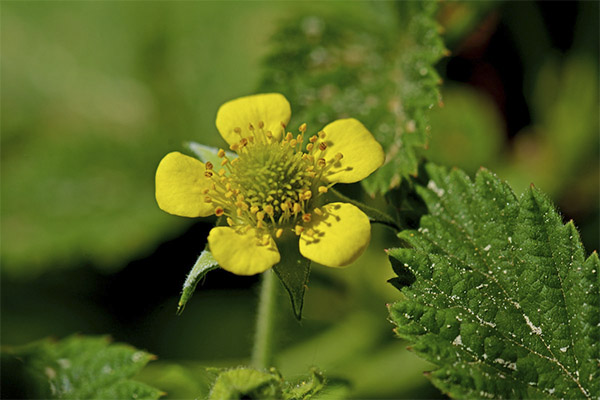
From calluses
To get rid of dry calluses, you will need a fresh, newly dug rhizome of gravilat. It should be cut in half lengthwise and bandage the cut to the callus overnight. Repeat the procedure daily until the blister disappears.
For colds
To make a drink that alleviates the cold, you need to take 15-20 grams of powder made from any above-ground parts of the plant - leaves, stems, flowers - pour it with boiling water and wait 3 hours until infused. After straining to drink two sips in the morning and evening. The drink will not only help to quickly cure a cold, bronchitis or sore throat, but also strengthen the immune system and become an excellent preventive measure against subsequent diseases.
Cleansing remedy
This composition is prepared only from the dried leaves of the plant. Grind them with your fingers to a powder and take 2 teaspoons of medicinal raw materials. Pour 2.5 cups of boiling water, warm for 20 minutes in a water bath. If you drink a tablespoon of such a composition during the day, the balance of trace elements in the body will be restored - such as iron, sodium and magnesium. This remedy also cleanses blood vessels and helps to heal difficult wounds.
Children for rickets
Baths with this composition are prescribed for babies over six months of age.
Gravilat is used as a component of an herbal collection, in which this plant is mixed in equal proportions with chamomile, nettle and succession. You need to take 4 tablespoons of the composition and boil for 15 minutes in water (3 liters). After straining, add it to the bath water (20 liters). The time of the water procedure is 10 minutes.
In diseases of the digestive system
Liver disease, cholecystitis and gastritis can be treated with a composition made from the root and herb gravilata, 10 grams of which are crushed and boiled for 10 minutes in 250 ml of water and pour the mixture into a thermos for 2 hours. Then filtered and drink the liquid during the day, dividing it into 4 parts.
In diseases of the kidneys.
Take 20 grams of dried herbs for 250 ml of water and boil the composition for half an hour. As it cools, strain and take 3 times a day before sitting down to the table, a tablespoon of broth. You can also rinse your throat with sore throat and mouth with stomatitis.
When bronchitis
To relieve coughs with bronchial asthma and bronchitis, it is recommended to take a powder of dried gravilita root before meals. Take the remedy by the tip of a teaspoon, take it with honey and drink water.
A styptic
- When uterine or hemorrhoidal bleeding for 30 minutes, boil 2 tablespoons of grated roots of the healing plant in half a liter of water. After cooling, strain and drink the resulting liquid throughout the day in small doses.
- In serious cases, you need a more intense decoction, which is prepared from 30-40 grams of root and one and a half cups of water. It should be evaporated on a low heat by half, strain and take a tablespoon every hour.
From gastritis
Prepare a medicinal herbal collection of gravilat, plantain, burnet and thyme, taken by a tablespoon each. Also add to it 3 tablespoons each of meadowsweet, chamomile, flaxseed, mother and stepmother, willow-herb, melissa and 2 tablespoons each of hop cones and heather. This amount is enough for a whole course of treatment, because daily intake of the preparation of the composition of only one tablespoon of the mixture, poured in a thermos 300 ml of just boiling water. Use after 6 hours of soaking and straining. Divide the liquid into three portions and drink each one half an hour before meals.
Types of medicinal compositions
The main medicinal forms in which folk medicine uses the medicinal plant - infusion, tincture and decoction.
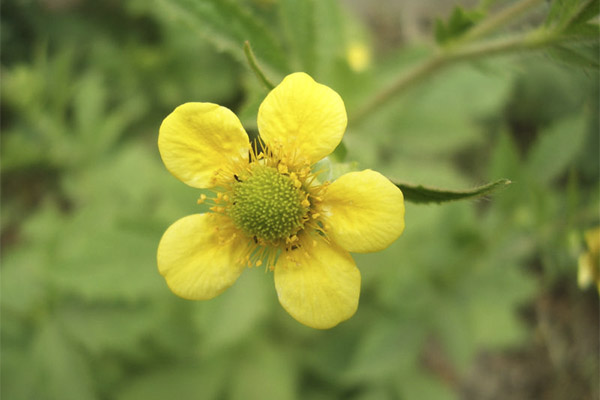
Infusion
- Infusion of the herb. This medicinal plant is good for calming the nerves. To prepare an infusion, pour a tablespoon of chopped leaves with a glass of boiling water and insist for at least two hours, strain and drink the resulting liquid during the day, dividing it into two parts.
- Infusion of roots - 1 option. Heal ailing liver, relieve gall bladder spasms and intestinal colic folk healers help infusion of the roots of gravilata. Chopped roots (tablespoon) scald a glass of boiling water and keep under a tightly closed lid and a warm towel for at least two hours, better even three. Three-hour infusion can be replaced by steaming in a water bath for half an hour. After cooling the composition to strain and take up to 4 times a day - before a meal, drinking 2-3 tablespoons at a time.
- Infusion of the roots - 2 options. In flatulence, diarrhea, vomiting, intestinal colic and even dysentery, an infusion of 2 teaspoons of finely chopped, freshly dug roots of the medicinal plant, poured 250 ml of water brought to a boil. After two hours of infusion in a tightly closed container to strain the product, divide into two equal portions and drink in the morning and evening half an hour before a meal.
Tincture .
- Tonic tincture. Pour a tablespoon of finely chopped fresh roots in 100 ml of vodka and insist a month in a dark place. Strain and drink 10-15 drops diluted in 100 ml of water before breakfast, lunch and dinner. It has a calming effect and is recommended for the treatment of nervous disorders, as well as gives vitality.
- Tincture for stomach cancer. In half a liter of vodka soak 5 large spoons of the root of the medicinal plant, previously crushed. Insist 2 weeks until ready. Treatment with this tincture is indicated as part of the complex therapy for patients suffering from stomach cancer. Norm of intake - from 20 to 30 drops three times a day an hour after meals. In some cases, healers prescribe a teaspoon of remedy for a single reception.
- Tincture on wine. Half a liter of wine requires 5 teaspoons of crushed roots of the medicinal plant. Infusion time - a week. The strained composition can be used to establish the process of digestion, reducing gas and stopping vomiting. Drink 50-60 minutes after a meal (3-4 times a day) a tablespoon.
Decoction .
- Boil 15 grams of fresh raw roots in 200 ml of water for half an hour. After cooling, filter it. This decoction gargle with a sore throat, as well as apply lotions to relieve joint pain at sprains and rheumatism.
- At a gentle boil, hold on the fire for 10 minutes a glass of water with a teaspoon of rubbed fresh rhizomes of gravilata. Then infuse for another hour, then strain and drink throughout the day, occasionally taking a small sip. Prescribed decoction to stop uterine bleeding.
- Over a low heat for 10-15 minutes, boil 250 ml of water with 2 teaspoons of fresh chopped root of the healing plant, then leave for 2 hours to infuse. This decoction is good to gargle your throat with for laryngitis or sore throat. The composition also helps to treat the oral cavity for gingivitis, stomatitis and other problems of the mucous membranes. Carry out rinses 4-5 times daily until the symptoms completely disappear.
- In a glass of hot water, stir a tablespoon of fresh, chopped into small pieces of the root of the plant and send for 20 minutes on a low heat, then remove and insist for another 50-60 minutes. Strain and drink by the tablespoon 20 minutes before a meal 3 to 4 times a day. Recommended for the treatment of dry cough in bronchitis.
Cosmetic Applications
Essential oil from gravilita is used extensively by companies that manufacture perfumes and cosmetics. It imparts a pleasant clove aroma to the products, and its antiseptic abilities have been used to make skin cleansing, analgesic and mild drying effects.
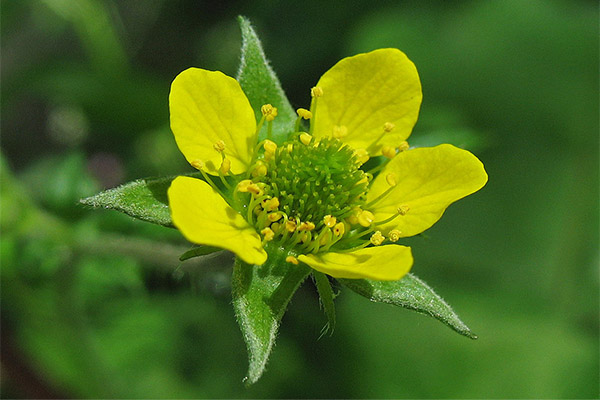
In home cosmetology, gravilat is used mainly for oily skin. With the help of a healing plant can reduce the amount of sebum, tidy up the dermis and regulate sweating.
Oily skin mask
A teaspoon of herbs gravilata boil in half a liter of water for half an hour. Remove the composition from the stove, strain hot and gently, in a small trickle, with constant stirring add 2 tablespoons of starch in the liquid. The resulting mixture cool for a quarter of an hour and put on your face for 30 minutes. During this half hour, do not do any business, relax and watch your favorite good TV program.
Body Bath
To improve oily skin, clean pores or reduce the manifestation of acne, which often appears on the back with oily skin, you must prepare a decoction of 8 tablespoons of the plant (suitable part of any gravilata) and a liter of water. Boil the mixture for a quarter of an hour, pour it into a thermos and hold it for a couple of hours more, then filter the decoction and pour it into the bath - and you can immerse yourself in water, enjoy and heal at the same time.
For skin rashes
Grind the dried rhizome of the healing plant in a coffee grinder until powdery. Take 2 large spoonfuls of powder and mix it with a tablespoon of pork fat, which should preferably be slightly heated. Lubricate redness, acne-type rashes in the morning and in the evening.
For eczema and skin irritations
On the skin of the hands affected by eczema, put the leaves of the plant, for greater effect, pre-mash them so that the juice appears. Secure the medicinal herb with dry clean bandages. Repeat the procedure once a day until the skin is fine. This remedy will also help to get rid of other skin conditions.
From swelling on the face and spider veins
Mix the usual amount of the usual day cream with a pulp, obtained by blender from fresh leaves of gravilat. Apply the creamy-herbal composition to the face and lie for about 20-25 minutes, then wash off the rest of the herb with warm water. The therapeutic effect is achieved due to the strengthening effect of the plant on the walls of blood vessels, increasing their elasticity. If such a procedure is carried out regularly, edema will not appear, and vascular spiders will eventually disappear.
Contraindications for application
The peculiarity of gravilata is that it predisposes to blood clotting, so it is not recommended for patients prone to blood clots, suffering from thrombophlebitis. Those who have low blood pressure should also give up trying to be treated with this medicinal plant.
Because of the presence of astringent and tannin ingredients in its composition, gravilat is forbidden to those who are familiar with chronic constipation. Pregnant women, nursing mothers and children are also contraindicated.
And, as with every medicinal plant, gravilat is certain to have components to which someone will have an individual intolerance. Such people should not use it.
«Important: All information on this site is provided for informational purposes only. information on this site is provided for educational purposes only. Consult your health care professional before applying any recommendations. specialist. Neither the editors nor the authors are liable for any possible harm caused by materials."

